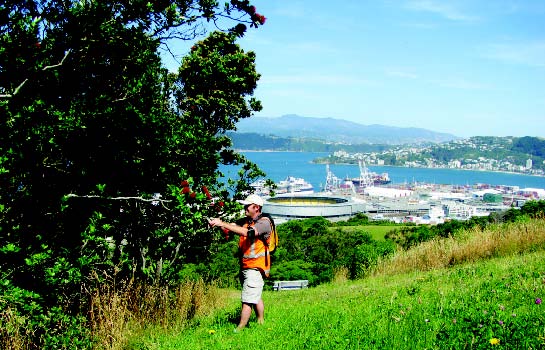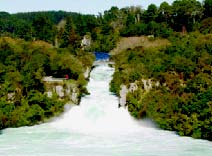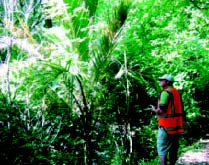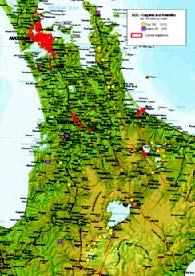PESTS AND DISEASES OF FORESTRY IN NEW ZEALAND
Biosecurity Surveillance for tourist risk sites
From Biosecurity 89, February 2009.
MAF Biosecurity New Zealand (MAFBNZ) has taken a Department of Conservation (DOC) biosecurity surveillance programme and expanded it significantly to increase the protection of New Zealand's indigenous forests from invasive pests and diseases.

New Zealanders recognise the beauty and magnificence of our native forests and scenery. We celebrate them every year by visiting in our hundreds of thousands, and, as their fame has spread overseas, tourists travel from far away to visit. The introduction of new organisms, and changes in the distribution of risk organisms already present, could cause significant harm to our unique range of flora and fauna. Without biosecurity surveillance of native forests, harmful organisms could have the opportunity to go undetected for long periods.
Why is there a problem?
Tourism is a recognised pathway for exotic organisms into New Zealand. Although baggage and personal effects are inspected at ports of entry, this is not 100 percent effective in detecting exotic organisms.
In the mid-1960s, air travellers' shoes and clothes were found to contain fungi (65 species in one trial) that could be a potential hazard for plants. In the early 1980s, tourists' camping gear was found to be a prospective pathway for the invasion of pathogenic fungi and live insects.
A major area of concern is where tourists initially camp after arriving in New Zealand, exposing tents and other camping equipment for the first time. Even just visiting scenic tourist spots and walking through indigenous forests has the potential to establish exotic organisms, for example from unclean boots, and to disperse weeds into previously clear areas.
Some history

The risk to the indigenous estate and the risk pathways have been recognised for many years. Out of 93 newly discovered pathogens and pests recorded in New Zealand in the 1990s, 18 were associated with indigenous hosts. For example, polyphagous (Latin for "eating many") exotic moths found in Auckland in the 1990s were proven to be a significant threat to the indigenous forests as well as plantation and amenity trees. One, the white-spotted tussock moth, was able to live and reproduce on native beech trees.

A report produced for DOC in 2000, evaluating threats to New Zealand's indigenous forests from exotic pathogens and pests, recommended that a structured surveillance system for indigenous forests be developed so that limited resources could be used to look at the highest risk sites in a way that would provide the greatest chance of detecting newly introduced pests or diseases.
In response to the recognition of risk from tourists, DOC began surveying the most popular first-night campsites (68 in total). The project began in 2001, with the main objective being the early detection of newly introduced invertebrates and diseases, and weeds that would be harmful to New Zealand's indigenous forests. Responsibility for this surveillance programme was transferred to the Ministry of Agriculture and Forestry (MAF) on 1 July 2005, under the re-organisation of biosecurity that gave MAF accountability for end-to-end management of the biosecurity system.
What is MAFBNZ doing now?
The original "first-night campsites" programme initiated by DOC has now been amalgamated with MAFBNZ's High Risk Site Surveillance programme (HRSS) and expanded to provide wider and more risk-based coverage. The range of risk sites surveyed and priorities for extending cover have also been reviewed using visitor numbers provided by DOC. For example, one of the most popular visitor areas is Huka Falls with over 600,000 visitors annually, including a significant number of overseas tourists.
Each of the selected risk sites has been carefully mapped and inspected, with efforts now concentrated on looking for new and significant pests. During the 2008/09 season, 130 tourist risk sites were visited and over 380 transects intensively surveyed. While a total of 14 samples were submitted to the Crown Research Institute Scion for analysis, no new pests were found.
In addition to tourist risk sites, urban HRSS sites around New Zealand, particularly including ports and airports, are inspected in the same way.
Who does the site inspections?

AsureQuality Ltd currently manages the HRSS contract for MAFBNZ. The main provider of field surveillance is SPS Biosecurity Ltd, whose directors have been involved in the quarantine, forestry and biosecurity fields for over 20 years. Many of the surveyors are extremely well qualified and have over 40 years of experience working in forest health and biosecurity.
What does the future hold?
In the future, risk data, such as updated tourist visitor numbers, results of slippage surveys and border pest interceptions, will allow improved profiling and ranking of tourist risk sites. This will allow direct comparison of risk between different types of risk sites.
While compiling a full list of all woody, herbaceous and aquatic weeds would be a significant undertaking, and regarded as a separate project, there is scope as part of the HRSS programme to collect woody weed data and record any new species without significantly increasing the work component of the surveillance. This would allow changes in weed composition to be measured over time, and could provide an early warning of new invasive weed species.
Paul Stevens, Senior Adviser (Plants Surveillance), Post Border, MAFBNZ, paul.stevens@maf.govt.nz

 Farm Forestry New Zealand
Farm Forestry New Zealand

